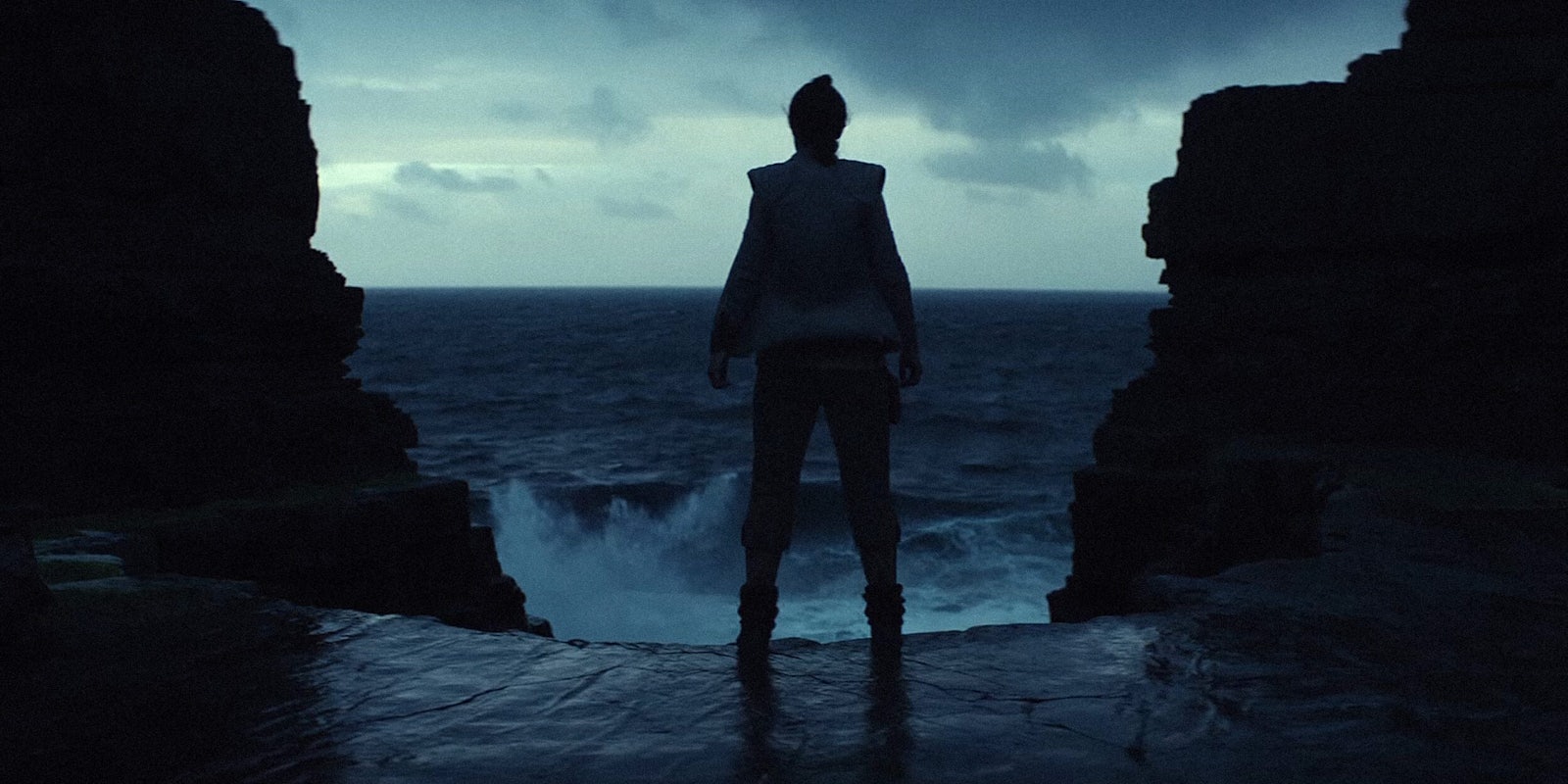It’s been a few weeks since we’ve gotten the first teaser trailer for Star Wars: The Last Jedi, and while fans have analyzed it to within an inch of its life, a major thread about its new hero continues to emerge.
Diving deep into any Star Wars trailer is, of course, part of the fun. Fans are constantly discovering new things about it, whether it’s the Easter eggs, old trilogy clips dispersed throughout, or finding out that we weren’t imagining Kylo Ren’s scar moving. But the teases released to date, which seems to hint that the franchise’s mythology will expand even further as Rey begins her training with Luke Skywalker, also hint that Rey might evolve beyond the Jedi.
For one, we have the teaser poster. Rey is standing in a classic hero pose holding her lightsaber (presumably Luke’s old lightsaber) up in the air. Luke and Kylo Ren are on either side of the light, and toward the top of the poster the blue light starts to blend in with the red background.
#TheLastJedi poster has been revealed. #SWCO pic.twitter.com/fqnf1bQtPu
— Star Wars (@starwars) April 14, 2017
Another big hint comes from the trailer itself. Early on, Rey is asked by Luke what she sees, presumably while they train.
“Light. Darkness. A balance,” she replied as we’re shown clips of Leia Organa, Kylo Ren’s mask, and several books on a shelf. As Rey says “a balance,” we see a hand touch the page of a mysterious page with a symbol associated with the old Jedi Order.

The Last Jedi director Rian Johnson confirmed last month that the film’s title refers to Luke (and is singular), so the trailer leaves us with at least a couple of questions: Will Luke abandon the Jedi ways? And what about Rey?
One potential theory brings in a concept that has precedent in non-canonical Star Wars lore, although any mention of Gray Jedi doesn’t come without legitimate caveats and asides. But could it be brought back into the canon, or is it too impossible in a galaxy far, far away?
A concept with a basis in Legend(s)
Depending on the person (or Jedi) you’re talking about, Gray Jedi could mean a couple of different things. It could refer to Jedi who operated between the light and dark side of the Force—aka a gray area—without succumbing to the latter. It could also refer to Jedi who didn’t adhere to the Jedi Code. Occasionally, a Gray Jedi would encompass both of these qualities.
In Legends—the Expanded Universe (EU) books and properties Lucasfilm no longer considers canon—Gray Jedi were around for thousands of years before Luke blew up the Death Star. Some of these Gray Jedi distrusted the Jedi High Council or believed it was overreaching its bounds. Others used qualities possessed by both Jedi and Sith without being seduced to the dark side of the Force.
Some considered Qui-Gon Jinn, Obi-Wan Kenobi’s master, to be a Gray Jedi in a retconned Star Wars comic because of his opposition to the Jedi High Council. Although his status as a Jedi isn’t called into question in The Phantom Menace, his previous defiances of the Jedi High Council as he pushes to have a young Anakin Skywalker trained as a Jedi are brought to light by Obi-Wan himself.
Ahsoka Tano, Anakin’s former apprentice who appeared in The Clone Wars and Star Wars Rebels, is cited as another example. She was expelled from the Jedi Order for a crime she didn’t commit and refused to rejoin it after her acquittal, which occurred toward the end of Clone Wars. While she crafted a new pair of white lightsabers after she left and could still use the Force, she didn’t consider herself to be a Jedi, even when she and Anakin—now Darth Vader—met once again in Rebels. She’s never been referred as a Gray Jedi in works like Qui-Gon Jinn has, but the unofficial label has followed her.
And while most of the EU has stayed in the EU, a handful of things have crossed over to canon, such as the appearance of Thrawn, an EU character who made his canon debut in Star Wars Rebels‘ third season as a major villain.
Is the Force is black and white?
For all of the talk about a gray area of the Force that appeared in the EU, Star Wars films have argued that, well, it doesn’t really work like that.
The characters we meet in the Star Wars films who studied the Force believed there were just two sides of the Force: the light side (followed by devoted Jedi) and the dark side (the Sith). Some, such as Yoda, believed that using the dark side of the Force would lead you to the dark side and not a kind of gray area.
“Once you start down the dark path, forever will it dominate your destiny,” he said in Empire Strikes Back.
He also noted how one could slip to the dark side of the Force in The Phantom Menace, telling Anakin he sensed fear in him and that fear can lead to the dark side.
Ezra Bridger, the protagonist of Star Wars Rebels, was also tempted by the dark side and used some of its abilities for a time, but he ultimately stayed on the path of the light side of the Force.
As far as we’ve seen, there’s been no gray area, and although heroes and villains have their own motives, the Force doesn’t bend so easily.
The “Gray-t Debate”
The idea of a Gray Jedi, in concept, is an interesting one. It introduces a potentially new—for most movie viewers, anyway—cornerstone of the Force that we previously didn’t recognize. Plus, with Luke being confirmed as the titular Last Jedi, there’s a marker for other known Force users like Rey and Kylo Ren (who isn’t a Sith) or the people we might discover to be Force-sensitive in the future.
It’s enough of a hot topic for some Star Wars fans that anyone who asked about it got an earful long before it became a possibility in The Last Jedi.
Among those who aren’t fans of the moniker is Lucasfilm Story Group’s Pablo Hidalgo, who once called Gray Jedi “a handy unofficial label.”
https://twitter.com/pablohidalgo/status/821480675463151617
https://twitter.com/pablohidalgo/status/822122445490429952
https://twitter.com/pablohidalgo/status/822122599303892993
The cut-and-dried nature of the Force, those against Gray Jedi argue, doesn’t lend itself to a buffer between the light and dark. One can stray a bit in one direction or the other, as we’ve seen play out, but ultimately they align with one side.
So basically, either you’re a Jedi or you’re not: There is no gray.
How possible is it that Gray Jedi will appear in The Last Jedi?
On one hand, anything is possible in a universe with a mystical, all-around Force that some people are capable of wielding on both the light and dark side. And given that Luke’s probably the only Jedi around right now (that we know of), any future knight would be operating outside of the Jedi High Council considering there aren’t enough Jedi to reform it.
Until we learn more about the movie—and watch it, for that matter—it’s hard to tell. As one person suggests, Luke’s comment about the Jedi ending might mean something else in the proper context than the one we’re being given. Trailers can be misleading. The book being pored over could be the Journal of the Whills, which does contain a passage about “the resolving of gray” and is canon (but has yet to show up in the movies).
No matter how this resolves, Rey has more challenges ahead of her beyond learning to tap into her powers. Her family is a big mystery, not to mention the looming threat of the First Order. Any mythological advancement is only a piece in the puzzle.
But if The Last Jedi does defy the odds and reveal a brand new aspect of the Force for the first time? They could sidestep the Gray Jedi debate and call it something else entirely.

